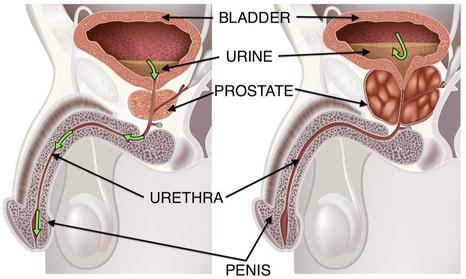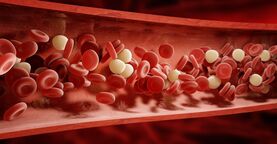Benign Prostatic Hyperplasia...The prostate gland sits like a doughnut around the urethra, which is the tube that drains urine from the bladder down and out through the penis. When the gland gets enlarged, a situation called Benign Prostatic Hyperplasia (BPH), it pinches off the urethra, making urination difficult or even impossible. Symptoms can include a weak stream, incomplete emptying, frequent urination, leaking, and rushing to the bathroom. Bleeding in the urine can also result. Many men get excellent relief from well-proven medications that are on the market. But when medications aren't enough, patients can choose among various procedures to help improve their urination. Normal Prostate Enlarged Prostate
|
Treatment Options...
Prostatic Artery Embolization (PAE) is a minimally invasive procedure for men with urination problems due to enlarged prostate glands. PAE is performed by an Interventional Radiologist, and is ideal for patients with large glands or severe bleeding from the prostate, patients who are too frail for invasive surgery, or for anyone seeking a less invasive treatment option. PAE is an outpatient non-surgical procedure that works well, with greatest benefits in patients with prostate glands bigger than 80mL (there is no upper gland size limit for PAE). PAE has a short recovery time with few long-term side effects: only about 1% of patients have problems with erections or urinary leakage after PAE.
Patients can also have a surgical procedure performed by a Urologist, such as TURP (Transurethral Resection of Prostate) or HoLEP (Holmium Laser Enucleation of Prostate). These involve placement of a rigid metallic scope through the penis and up into the prostate gland while a patient is under general anesthesia. A device is then used to shave out the problematic prostate gland tissue. These procedures are the current standard of therapy because they deliver unparalleled improvements in urine flow. However there can be a long recovery time afterwards, and side effects may include bleeding, pain, or problems with erections or bladder control. Surgical removal of the prostate (prostatectomy) is yet another more invasive option which can be considered sometimes. |
PROSTATIC ARTERY EMBOLIZATION...
Procedure Details
PAE, or Prostatic Artery Embolization, is a less-invasive alternative to the TURP or HoLEP operation. PAE is done by placing a tiny tube into the arteries that feed the prostate gland, to shut down the blood flow to the gland by injecting thousands of microscopic beads to clog the prostatic arteries up. Everything is done through a tiny hole in the skin. General anesthesia is not necessary because PAE is not very painful. Patients usually go home the same day with a small bandage, and have only about a week of recovery time before returning normal life. Over time, the prostate gland is starved of its blood supply, and it "shrivels up," like a grape shrinking into a raisin. The urethra opens and urine flow improves.
|
What to Expect
There is usually about a week of recovery, and then usually by the third or fourth week after, urination starts getting a lot better. But you should understand that the gland shrinkage happens gradually over a few months. About 7 out of 8 patients will have good results. For men who suffer with urinary catheters in place, about 3 of 4 patients get the catheters out for good. For many, PAE can be life-changing. Patients will seldom have any lasting negative side effects. For those who don't experience the full benefit of PAE, they can still undergo any other BPH treatment. In fact, if a more invasive BPH surgery becomes necessary, PAE can help make that surgery safer and easier by shrinking the gland to control bleeding.
|
ResultsThe procedure is approved by the FDA and is paid for by Medicare. Although PAE does not yet have as a long a track record as surgical procedures like the TURP, many large-scale studies have proven that PAE is safe and effective, and this procedure has been done in the USA for ten years with great results. All patients who are considered for this procedure also get a full evaluation by a Urologist, so they can understand all the options and choose what is best for them. By partnering with dozens of urologists in the region, I have done more of these procedures than anyone else in the northeast United States.
Medicare will cover PAE without issue. Most health insurance companies will cover PAE if appropriate need can be demonstrated, typically if a patient has significant bleeding from the prostate. We will do everything possible to help make PAE available to you. You can even watch an actual live case here. |



